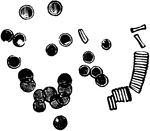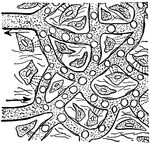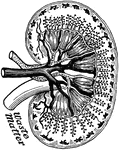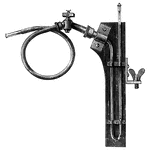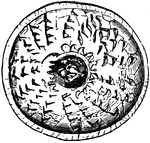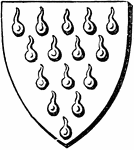Clipart tagged: ‘blood’
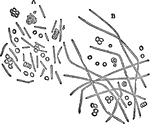
Bacillis Anthracis
"A. Bacilli mingled with blood corpuscules from the blood of a guinea-pig; some of the bacilli dividing.…
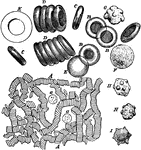
Blood Cells
Blood corpuscles. Labels: A, magnified about 400 diameters. The red corpuscles have arranged themselves…
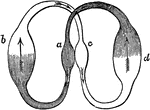
Blood Circulation in the Heart
Diagram showing the circulation of blood in the heart. Let a represent the right side of the…
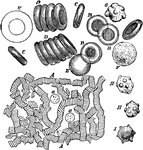
Blood Corpuscles
Blood corpuscles (cells). Labels: A, magnified about 400 diameters. The red corpuscles have arranged…

Intracellular Network of Blood Corpuscles
The intracellular network of colorless and colored blood corpuscles. Labels: A, The colorless blood…
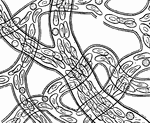
Circulation of blood
"Showing how the circulation of blood in the web of a frog's foot looks as seen under the microscope."…
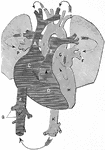
Circulation of Blood
A diagram illustrating the circulation of the blood. Labels: A, vena cava descending (superior); Z,…

Diagram of the circulation of the blood
"R.A., right auricle; L.A., left auricle; R.V., right ventricle; L.V.,…
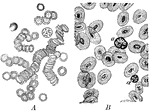
Corpuscles of Human and Animal Blood
A magnified view of corpuscles of human blood compared to animal blood. Labels: A, corpuscles of human…

Circulation of Blood in a Frog's Foot
The circulation of the blood in the web of a frog's foot. A, an artery; B, capillaries crowded with…

Gladiators
This illustration shows various types of gladiators, each type with with his specific weapons attributed…

Gland
"Diagram to show the working parts of a gland. v and a are blood tubes with thin-walled branches around…

Heart
"The heart and blood-vessels diagrammatically represented. L, lung; M, intestine; P, liver; dotted lines…
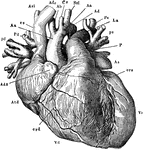
Heart
"The heart and the great blood-vessel attached to it, seen from the side towards the sternum. The left…
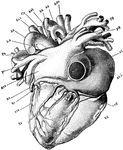
Heart
"The heart vied from its dorsal aspect. ci, inverior vena cava; Vc, coronary vein; Atd, right auricle;…

Heart and Blood Vessels
The heart and blood vessels diagrammatically represented, showing the direction of blood flow.
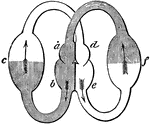
Heart, Compartments of
Diagram showing the compartments of the heart. The smaller compartments are the auricles (also known…
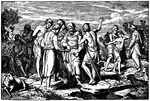
Joseph's Brother Sell Him into Slavery after Pulling Him Out of the Cistern
"Come, and let us sell him to the Ishmaelites, and let not our hand be upon him; for he is our brother,…
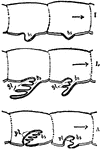
Lamellae
"Diagram to show the way in which an outgrowing gill-process bearing blood-holding lamellae, may give…

Communion of the Apostles with Jesus at the Last Supper
"And as they were eating, he took bread, and when he had blessed, he brake it, and gave to them, and…

Horse Leech
The horse leech, similar to the medicinal leech, feeds chiefly on earthworms and on other leeches.
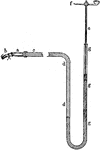
Manometer
"Mercury manometer for recording blood-pressure. d g, glass U-tube partly filled with mercury. In one…

Medicinal Leech
The medicinal leech is a leech used in bloodletting. It lives in fresh water, and is common in Germany,…

Muscles and Blood Vessels
"Principal Muscles on the Right, Certain Organs of the Chest and Abdomen, and the Larger Blood Vessels…
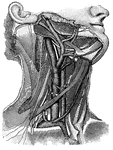
Blood vessels of the neck
"Showing the carotid artery and jugular vein on the right side, with some of their main branches; also…
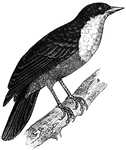
Bloody Pavao
The bloody pavao (coracina scutata) is a mostly black bird, which gets its name from the blood…

Tool Combination Rake
A long-handled implement with a row of projecting teeth at its head, used especially to gather leaves…

Scorpio Embryo
"Embryo of scorpion, ventral view showing somites and appendages. sgc, Frontal groove. sa, Rudiment…

Section of Human Kidney
This illustration shows a section of a human kidney (A, Cortical substance; B, Pyramids; C, Hilum; D,…
Spearhead Imbued
"IMBUED. Weapons spotted with blood are said to be imbued. The example shows a spearhead imbued." -Hall,…

The Death Angel Passes Over an Israelite Door Marked with the Blood of a Lamb
"And the blood shall be to you for a token upon the houses where ye are: and when I see the blood, I…
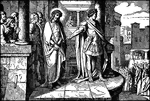
Pilate Brings Jesus Before the People and They Ask for His Crucifixion
"Pilate saith unto them, What then shall I do unto Jesus who is called Christ? They all say, Let him…

White Blood Corpuscle
A white blood corpuscle sketched at successive intervals of a few seconds to illustrate the change of…



